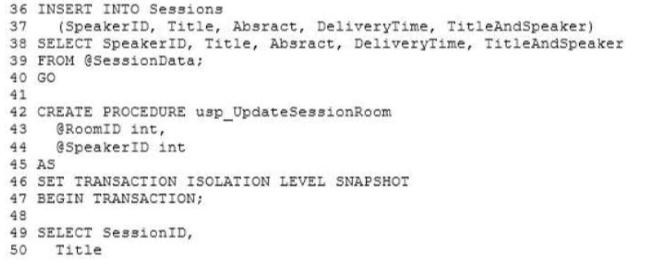Case Study 6: Database Application Scenario
Application Information
You have two servers named SQL1 and SQL2 that have SQL Server 2012 installed. You have an application that is used to schedule and manage conferences. Users report that the application has many errors and is very slow. You are updating the application to resolve the issues. You plan to create a new database on SQL1 to support the application. A junior database administrator has created all the scripts that will be used to create the database. The script that you plan to use to create the tables for the new database is shown in Tables.sql. The script that you plan to use to create the stored procedures for the new database is shown in SQL1 to support the application. A junior database administrator has created all the scripts that will be used to create the database. The script that you plan to use to create the tables for the new database is shown in Tables.sql. The script that you plan to use to create the stored procedures for the new database is shown in StoredProcedures.sql. The script that you plan to use to create the indexes for the new database is shown in Indexes.sql. (Line numbers are included for reference only.) A database named DB2 resides on SQL2. DB2 has a table named SpeakerAudit that will audit changes to a table named Speakers. A stored procedure named usp_UpdateSpeakersName will be executed only by other stored procedures. The stored procedures executing usp_UpdateSpeakersName will always handle transactions. A stored procedure named usp_SelectSpeakersByName will be used to retrieve the names of speakers. Usp_SelectSpeakersByName can read uncommitted data. A stored procedure named usp_GetFutureSessions will be used to retrieve sessions that will occur in the future.
Procedures.sql



Indexes.sql

Tables.sql

------------
Question
You need to provide referential integrity between the Sessions table and Speakers table. Which code segment should you add at line 47 of Tables.sql?
A. ALTER TABLE dbo.Sessions ADD CONSTRAINT
FK_Sessions_Speakers FOREIGN KEY (SessionID)
REFERENCES dbo.Speakers (SpeakerID);
B. ALTER TABLE dbo.Speakers ADD CONSTRAINT
FK_Speakers_Sessions FOREIGN KEY (SessionID)
REFERENCES dbo.Sessions (SessionID);
C. ALTER TABLE dbo.Sessions ADD CONSTRAINT
FK_Sessions_Speakers FOREIGN KEY (SpeakerID)
REFERENCES dbo.Speakers (SpeakerID);
D. ALTER TABLE dbo.Speakers ADD CONSTRAINT
FK_Speakers_Sessions FOREIGN KEY (SpeakerID)
REFERENCES dbo.Sessions (SessionID);

